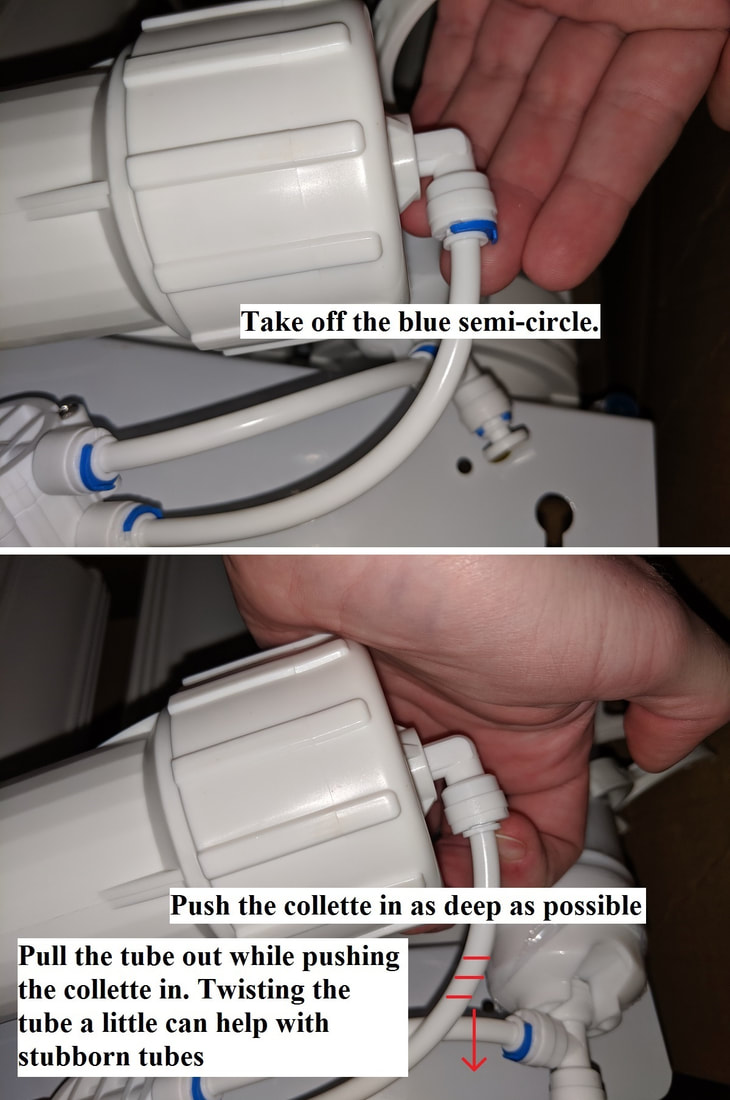Home RO help and FAQ
How often should I change filters and membranes?
|
It depends on the system and filters, how often the water system is used and what's in the water being filtered. Each system and location will be a little different. There are some good guides, though.
1) In a typical home RO system, the first filter is a 5 Micron sediment filter. This filters out sediment of 5 microns (5/1000th of a millimeter) or larger. 2) The second filter depends on if your water source is municipal or not. A) In a home RO system that uses municipal water, a Carbon Block Filter is needed. This filter is specially designed to take as an method in removing chlorine and its by-products (TTHMs) and volatile organic compounds, and certain organic compounds both natural and man-made, among other things. OR B) If you're not on municipal water, the second filter should be a 1 micron sediment filter. This removes more than the 5 micron filter, but because the 5 micron filter gets used first, it experiences a longer lifetime and is able to focus on finer particulate that are more common to untreated/well/local water sources. 3) The third filter should be a GAC (Granular Activated Carbon) filter, which removes harmful chemical compounds through adsorption. The very high surface area of the carbon in these filters provides excellent filtration for chlorine, and harmful organic compounds. 4) The membrane is the workhorse of the Reverse Osmosis system. It's where the main, fine filtration happens. By creating a zone of pressure that forces water through the membrane, very fine particles are filtered out, leaving clean, safe drinking water. 5) Post storage tank inline GAC filter. This will be the last filter in the line (second last if you have a remineralization filter, but most people don't) before the water goes to the faucet. It filters the "rubbery" taste from the storage tank, and has an average lifespan of 2-3 years. |
What do I do with old filters or membranes?
Old filters and membranes can be discarded normally. There are no special precautions or disposal procedures.
How do I get the tube out?
|
Removing the tube in order to replace membrane can be a little tricky if you're not familiar with colletts.
The collette that keeps the tube in the fitting works sort of like a finger trap. If you push the collette in with a fingernail or flat edge of a butter knife, or pliers, or a similar tool, you should be able to pull the tube out. Sometimes a little twisting can help if it's stuck even when the collette is pushed in. |
I have a bad taste, what do I do?
Bad tastes can be caused by a variety of issues. The most common is an expired inline GAC filter. The storage tank can sometimes leave a "plastic" or "rubber-like" taste. Changing the inline filter will solve this problem.
How do I change a filter cartridge?
- Turn off the feed water valve to the R.O. system. If you're unsure where it is, look for where the cold water line attaches to the first filter cartridge of the R.O. system.
- Open the faucet and allow the pressure to bleed off. This may take a few minutes. Keep the faucet open to prevent an air-tight seal from creating a vacuum that makes it near-impossible to open the cartridge.
- Unscrew the filter housing and discard the used filter cartridge. A specially designed wrench is available with your dealer if you don't have one.
- Remove the o-ring from it's groove and rinse out the housing. Clean with a clean soft rag or towel. Inspect the o-ring for any damages or wear-and-tear, and replace if necessary.
- Lubricate o-ring with a food-grade silicone lubricant (such as Chemplex 862) and put it back into it's groove. The o-ring is extremely important for creating a water-tight seal.
- Remove the new filter from it's packaging and place the new filter in the cartridge. Make sure it's centered, and carefully screw the housing on. HAND TIGHTEN only. DO NOT over crank. The threading, structure of the housing, and o-ring can all be damaged by over tightening.
- Open the water supply valve and allow water to run from the red/orange line until you get a steady stream of water.
- Turn the storage tank on and allow water to flow from the R.O. faucet until it runs clear. Close faucet. The system is now ready to use.
|
`
|
DYNA-PRO ENVIRONMENTAL
575 ROSEBERRY ST WINNIPEG MB TOLL FREE: 1-800-284-6315 |







